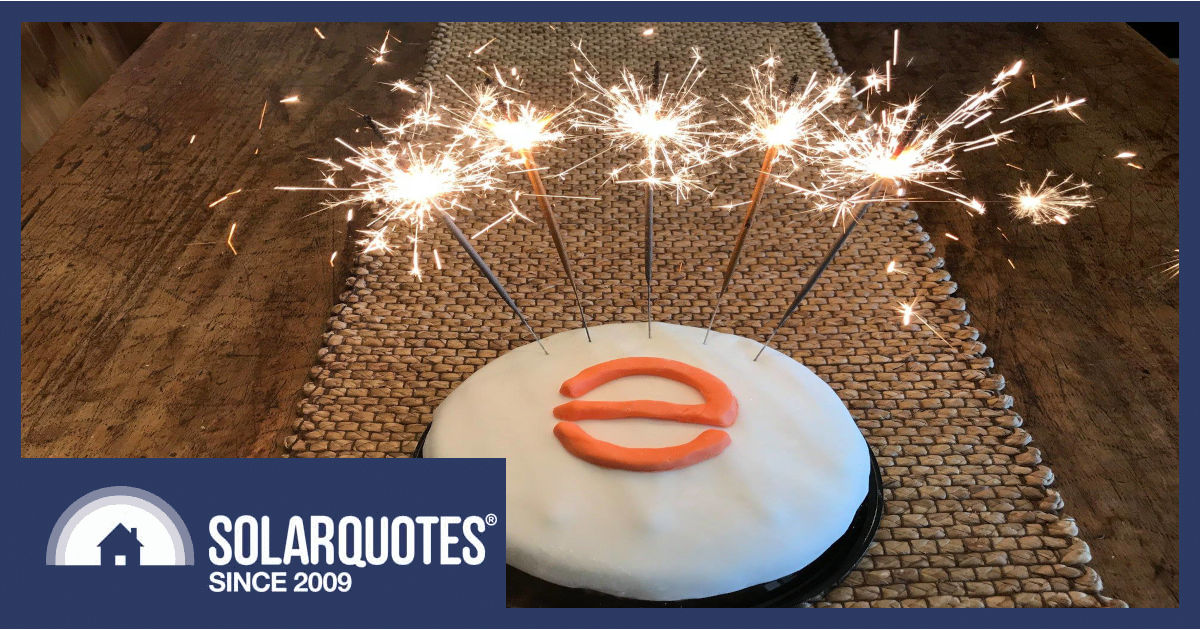
Thanks for the image, Matt Hines
Certain products earn a loyal following for a reason, and Enphase, the world’s biggest microinverter maker, is no exception.
While some other microinverters have proven unreliable, Enphase offers a solid product and sound after-sales support. Enphase also offers a comprehensive app, a whole-home energy management system, a brand-new EV charger and a battery solution.
There are use cases for microinverters where nothing else will do, such as the increasing number of small townhouse roofs with single panels scattered all over them. If all you have to work with is a needlessly complex roofline, then I have no hesitation recommending them.
Enphase Advantages
Enphase has always been keen to sell itself as the last word in efficiency, and I can’t argue with long-term results like these published by the inimitable Positronic Solar in Brisbane. Some people have sought to throw some shade at them, but shaded roofs are where Enphase microinverter based systems really shine.
And, of course, they’re always noted for being beautifully neat and super safe because there are no fire-prone DC isolators or high-voltage DC cables running anywhere. It’s simply an AC circuit up to the roof, much like an air conditioner.
Enphase Problems
Powerline Comms
Having installed Enphase microinverter based systems, I genuinely appreciate what they offer. However, my enthusiasm is dampened by “simple” powerline communications that need filters and ferrite cores to make them work consistently. In theory, it’s perfectly straightforward: hook up all your inverters on the one AC power circuit. But the reality of getting them to talk by superimposing a signal on top can be fraught with problems caused by interference from other random sources.
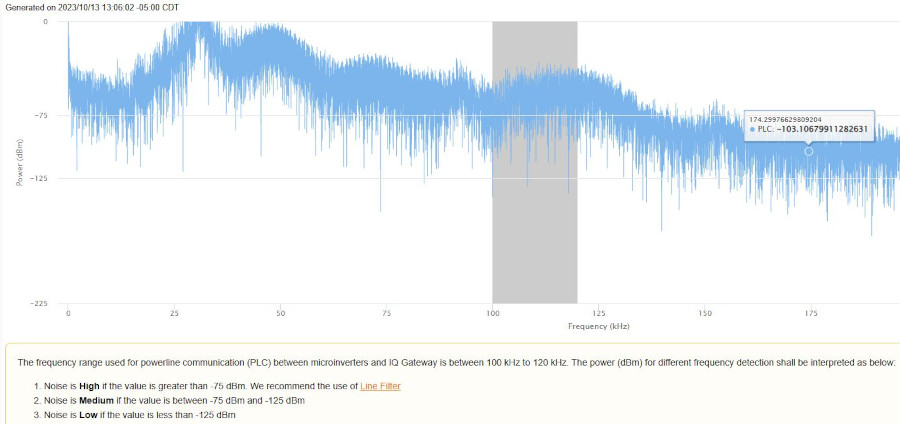
The grey band is where Enphase transmits all the monitoring and control data down the same wires that power your house. Lots of static on the line will cause problems.
The Frustrating Australian Enphase Website
What’s even more frustrating is Enphase’s poorly maintained Australian website. Outdated tools fail to list the latest micro inverters or redirect users appropriately. Hovering over the “Support” tab conjures a list that vanishes before you can click on it. Using the configurator leads to yet another disappearing menu, making it difficult to reference the Bureau of Meteorology for essential temperature data.
The old configurator doesn’t even agree with the new one, and the answers you get for system design rules are inconsistent. When you enter the details for a new REC Alpha 470 , the IQ7X might get a tick, or it might not.
To give credit where it’s due, the company’s phone support is commendable, and that’s undeniably good news. In under 6 minutes, they emailed me a weblink featuring IQ8. Yet, it was vexing to discover a list that included four different Hanwha – Qcells companies but nothing for the popular Q.MAXX model range.
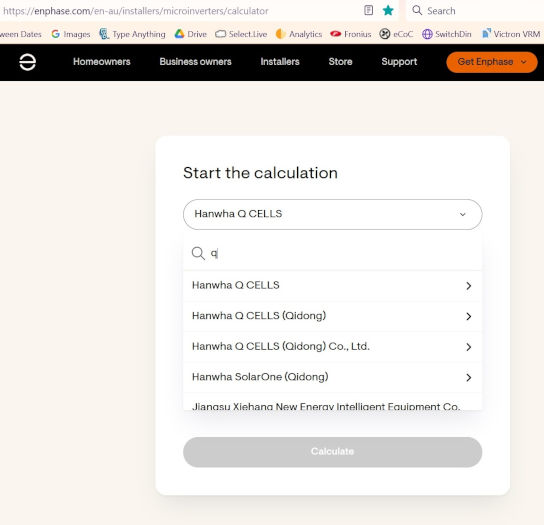
When the list isn’t updated, you must find the specs and enter 6 numbers, plus the temperature numbers from the BOM where Enphase has another broken hyperlink.
Sunlight Backup: Promised But Not Delivered
In the role I have providing advice and answering questions for the uninitiated punter, Enphase makes life hard because the “backup without a battery” feature they offer in the US hasn’t been released here. But you can find reference to sunlight backup on the Australian website and clicking the link opens an ambiguous 404 error. This should explicitly say that ‘sunlight backup’ is unavailable in Australia.
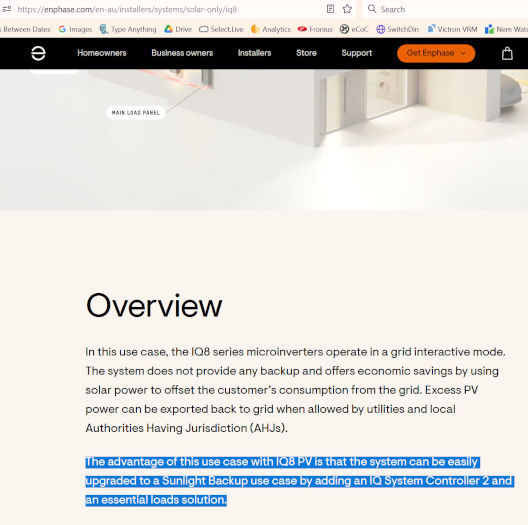
The blue text is misinformation in Australia, and the “Authorities Having Jurisdiction” is a dead giveaway that a local hasn’t edited this.
Further confusion is created when you look for a battery solution and find one listed on the Australian site, using old model inverters, and a battery that has never been seen here. This is a great way to confuse potential customers. It can be hard to make sense of the options as a consumer, when there’s a buzz about a new battery, but full energy independence returns another broken link.
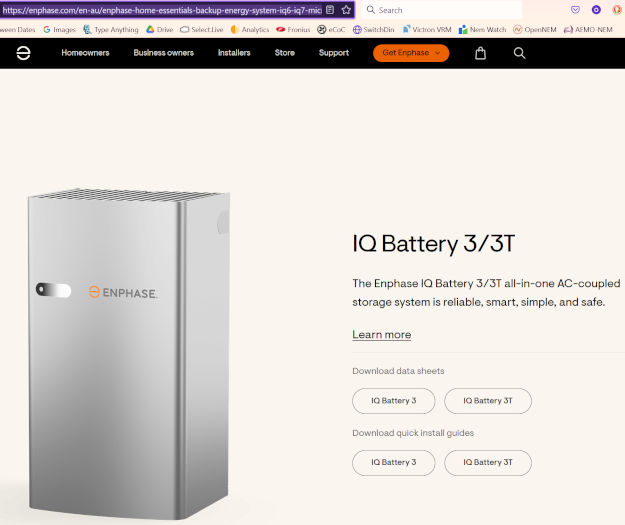
What is it with tiny 3 kWh batteries?
Finding Current Ratings Is Hard Work
If you click on the various tabs that explain the features of different model microinverters, then scroll to the “Technical Specifications” tab, it lists; the voltage range, peak output power, suitable panel wattage, plus the fairly useless figures for length/width/height/weight.
But what if you want the current rating, a fundamental number for your design? You have to find a different page or download a PDF for that. It makes me want to shout at the clouds.
Enphase Energy Yield Is Great – If Designed Properly
Hidden in the same Enphase website, there’s a treasure trove of valuable information. The back end offers an abundance of in-depth studies on real-world Australian installs. Enphase should be commended for having such great commitment and cultivating a following of really clever installers. Together, they have meticulously explained how to get an extra 0.025kWh per panel per day…
You’d be right if that doesn’t sound like they’re playing for cattle stations, but it shows they’re serious about being billed as the absolute best. And it slightly boggles the mind when some installers don’t deliver on the promise.
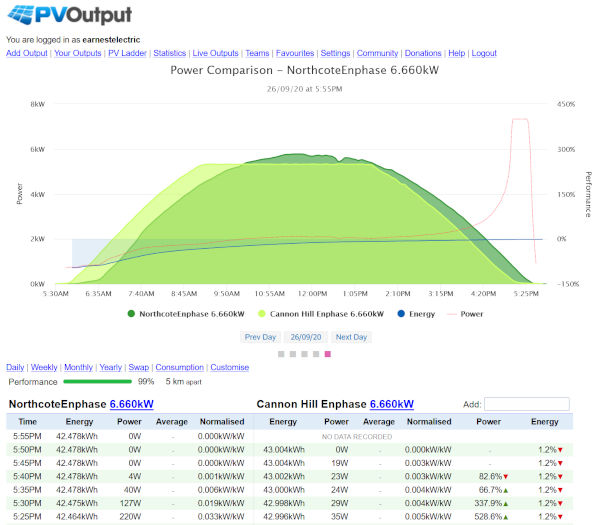
Two 6.6 kW Enphase installations, one clipping, one not. You could argue the installer of the light green system is short-changing the customer, who has likely paid top dollar for Enphase microinverters on the brand’s core promise that they’ll squeeze every last kWh from their panels.
Electronics Hate heat
I’ve always been wary of electronics enduring scorching rooftop temperatures. Enphase microinverter units are completely solid-state and claim superb reliability, but I would rather live in the shade under a fan. If you have to lift parts of a solar array to service inverters, it can be expensive.
Long Cables? Avoid Enphase.
It’s also worth mentioning that if you have long cables to your shed or from the street, a string system running DC at 600 volts has lower losses than an Enphase system at 230V AC,
One of my more memorable jobs was installing 50 metres of cable tray and 200 metres of fat copper cable through the Salisbury Library Building for a 30-odd kilowatt Enphase microinverter based system. It was a lot of work and expense to keep the losses below 1% for solar, cost that could be lowered when DC solar strings run 400% higher voltage than the AC supply in the building.
Enphase Is A Closed Shop
And these days, we are increasingly finding that the Enphase attitude, a closed shop (no accessible APIs for third-party smarts like Solar Analytics or ChargeHQ to work with), is just making things difficult unless you go all in for Enphase everything at the outset.
Enphase App Is Lousy
The laughable part is that many people have an Enphase system with Tesla Powerwall, and while panel level monitoring is a big Enphase selling point, it seems most people forget to look at it because the Tesla app is much prettier, easier to use and intuitive to understand. This old post from Finn details how painful it can be to use the Enphase app.
We can only hope the latest version of the Enphase app has a better user interface.
Enphase’s Latest IQ8 Microinverter: Finally Here
Like the physically enormous Enphase battery, the IQ8 microinverter has been a long time coming. The initial promise of them being “here by Christmas” evolved into an enduring industry joke, mainly because nobody could predict which year Enphase Christmas would arrive. There was a FAQ put out mid-2020, promising 2021, for a product delivered mid-2023.
With the rise of high-current 13 amp panels, IQ8 is needed, but there’s still no Enphase microinverter for a nice high-voltage REC Alpha 470w panel without clipping current or missing out on STC payments.
Enphase Is The Market Leader
We mustn’t forget that Enphase stands as a market leader in microinverters for a reason. They offer a great product with unique capabilities and an outstanding warranty. Being part of a much larger global operation gives them the resources to maintain an excellent technical support line, even though they may have overlooked properly maintaining their Australian website.
I know a lot of really reputable solar installers, successful businesses, and smart people, some whom stake their entire operation on Enphase. They have no doubts about the quality of the systems they deliver, and it’s great to see them passionately explain why.
I Would Like Some Answers Though
There have been some installer-level Enphase design problems drawn to my attention recently. It’s not the end of the earth; it doesn’t threaten your warranty, but when you pay a premium for Enphase microinverters, getting a second-rate yield leaves a bad taste in your mouth.
The responses I’ve had trying to raise the issue have been, at best, muted. I’m not keen on throwing bombs, but there seems to be a reluctance to address the embarrassment caused by a savvy customer using Enphase web tools to point out fundamental flaws. Next week, I’ll outline a conflict I’d love to see settled amicably.

 RSS - Posts
RSS - Posts



some enphase micro inverters were banned in germany because of the very high noise levels inhibiting the garage door openers. only small loop area panel routing and ferrites could solve it.
I have a bunch of IQ7A inverters on my roof. Never been a problem using the Enlighten App. Easy to use and easy to navigate through. I don’t see that the App is “Lousy”. Overall production & consumption displayed, Live status of the system, Panel level monitoring to ensure every 7A is working and working optimally. It may be that some additional information on the App would be of some benefit to some owners. I’m thrilled with my 7As.
Thanks Anthony, I wish I was better informed before accepting the suggested panels to go with my Enphase system. The panels have an MPP at 13.25A so with my new 415W panels I only see a maximum of 310w with IQ7A inverters rated at 10.2A max input. That’s on a perfect cold morning with good sun. Very disappointing.
Just to be clear, this isn’t particularly an Enphase mistake but that of the installer. I wonder how many other are similarly affected?
Hi Shaun, I’m experiencing the same issue. I’ve had multiple discussions with the installer and reached out to Enphase hoping they could resolve it through firmware updates, similar to what they’ve done with their IQ8As, but unfortunately, no progress so far.
We are happy Enphase users since 2019.. added more panels, now 13.3kW and 10kW of IQ7+/IQ7A’s and 3 x Powerwall 2 batteries through Covid. All on Single phase in Melbourne. Great install via G-Store.
Agree about the app, my installer didn’t even fully configure it, said I’d never use it (we got a Powerwall at the same and use the Tesla app). it is useful to show individual panel performance though.
Have you come across the ChiliconPower microinverter brand? This brand is now owned by Generac Corp from the USA. However, before being acquired by Generac they were an all USA made micro-inverter. I have found them to be a reliable brand but not as well known.
I have just had a iQ8 system installed with new Trina 440w panels, a 5p battery all controlled by the Controller 3. I am a bit disappointed with the app, it is in my view fairly basic. Having a battery it would be good to view a few parameters of that battery, other than just percentage of charge! Also we are now export limited to 1.5kw at any one time, so what happens now in the app you NEVER know what your production really is! All you get is the production after the export limiting, how silly is that? As for individual panel monitoring, that simply does not work anymore, again you will NEVER know if a panel is underperforming, because they do not all show what they have produced during the day, they only show you the amount after they have deducted the export limiting amount. The only thing the panel monitoring is any good for now is to see if one is completely out.
Another system that I monitor same capacity with iQ7+ but was installed prior to the export limiting regs, shows today at this moment dull day, 20kw produced and mine shows 12kw. Absolutely no reason why there should be that difference apart from export limiting hiding the actual production. Disappointing also that my older system is unable to help charge the battery, we have had two different plans given to us by two different Enphase engineers, one allowed connection to charge the battery the other not, the installer chose to use the plan that simply feeds the output into the grid without any of it being used during the day, as the new system provides all the instant power. So our old system is not worth more than junk, instead of having some use, which was one reason why we went with Enphase for our new system, to hopefully continue to benefit from money previously spent on an earlier system. I cannot believe that AC being fed into the controller which then converts it to DC to charge the battery is any different to the AC coming from the new system. Disappointing.
Our WIFI router broke, so we replaced it with a new one. The new router despite being configured for the same User-Name and Password, requires all of its Clients to be individually re-authenticated. That was about 10 days ago.
For some unknown reason, the Enphase installer mounted the Envoy device behind the circuit breaker panel. The Envoy being not owner accessible we are unable to connect our solar system to the new Wi-Fi router;
After our initial contact with the installer re this, he has fallen silent.
Hopefully a local electrician will be around tomorrow to temporarily remove the SWB panel so that we can press the appropriate button.
Get them to re position the Envoy, you need access to this thing.
“Long Cables? Avoid Enphase.”
Sometimes you guys can be confusing, I am getting ready to install a solar system on a shed roof, a somewhat shaded in the forest shed roof. I intend to put every thing I am allowed or can fit on a 7m x 9m roof. It is in a paddock about 60m from the house power board and will have to fly, possibly twice to get to the house. I have to rely on a contractor to design this and sell me correct, optimal materials installed well, my confidence is waning. I’m talking to one of your recomended contractors.
Hi Mike,
We have a couple of blog posts that might help clarify but it will be helpful if you get an electrician to check you mains cable size and do a voltage drop calculation to see what you have as a baseline. That will inform you on how fat the AC cables need to be for the shed to achieve the ideal 2% total loss. Bear in mind if you get a hybrid inverter and want a battery later it might be worth putting that unit on the house in any case. If you’re running any new wiring to the shed then I would add a second conduit and some cat6 cables in any case.
Cheers
https://www.solarquotes.com.au/blog/solar-voltage-rise-drop/
https://www.solarquotes.com.au/blog/shed-solar-distance/
I would recommend that you talk to Enphase themselves, give them all your specs and they will do a design, if they are reluctant to deal with you personally then your installer should have engineer access. If he is in any doubt at all about what he needs to achieve a good outcome then he must talk to ENPHASE. I know I have complained about getting two different answers but I still believe that Enphase offer fantastic service that you do not get anywhere else, so it is worth talking to them. Bear in mind that many installers really have NO experience with the Enphase system or certainly very limited, so there is no shame for them to talk to Enphase, also many people are often reluctant to contact the manufacturer, and in many cases it is impossible to do, but Enphase make it perfectly possible. On our property we have 70m between the house and the pole where our utility meter is on our side of the fence more or less on the verge. So if there is any losses due to the cables having to transfer AC all that way it is not obvious. If you have shading issues then Enphase system is likely to make up for any losses in your cabling. In my view. Good luck.
Good point Jackie,
Support is important and Enphase do it well.
Hi Mike,
I am considering Endphase for our system when we get one.
Could you explain your comment ”If you have to lift parts of a solar array to service inverters, it can be expensive”.
We live in Darwin and have been told that Endphase/microinverters aren’t the best option for the tropics. Not only do we get hot days all year round, we also get torrential rain during our wet season.
Does your comment above mean that microinverters will not be as reliable in hot climates such as ours? Would we buying something that will result in expensive servicing?
I’ve tried to get to the bottom of this question about microinverters for our climate for awhile.
Hi Leanne,
It’s just labour intensive to have to disassemble an array to get to the inverters, to undo the clamps and lift the panels is much the same as building a new system. In fact it can be worse if the hardware is seized. Despite being stainless steel and aluminium, corrosion can lock things solid making it difficult to get apart & impossible to salvage. I really recommend putting “never seize” type compound on all the threads, even if you have to ask the installers for a box of parts do it yourself the day before install.
Micros are great for complex roofs and shaded positions. I could make an argument for or against them in the wet tropics in terms of plugs and connections being at risk of getting damp. For my money a Fronius string inverter with a fan is the best answer in the heat.
Not sure why you think that it is likely to have to disassemble an array to get to a micro inverter. In general they are very reliable from my experience, and given panels all have plugs to go into wiring, these will surely be just as “at risk” as any others, and you need these no matter what inverters you use. Given that the Enphase micro inverters are fully sealed, as against a string inverter which is likely to have NO sealing and would therefore be open to the humidity the north, one could imagine a fully sealed unit is far less likely to suffer from moisture ingress than a non-sealed unit, no matter if it is on the roof or not. The micro inverters are pretty protected being mounted under the panel, from both the sun and the rain. Unless you can come up with a better argument it would not stop me from using Enphase. Using something like “never seize” should be part of the specs of building an array, but isn’t.
Hi, I’m having IQ8AC’s and Jinko JKM440N-54HL4-V panels (x19) installed next week in Brisbane. The installer is one recommended by solarquotes. Is there anything the installer should be looking out for installing this system? I want to make sure it is installed correctly to maximise output. Thanks, Paul
They’re quite compatible Paul.
Details can be entered here but that module isn’t in the drop down list sadly
https://enphase.com/en-au/installers/microinverters/calculator